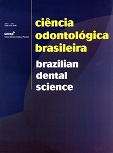Microstructural analysis of restorative materials submitted to acid exposure
DOI:
https://doi.org/10.14295/bds.2012.v15i1.710Keywords:
materiais restauradores, erosão ácida, rugosidade, microdurezaAbstract
The study aimed to evaluate, through surface roughness and microhardness tests, the amount of damage caused by hydrochloric acid to restorative materials. Five different materials were used: direct composite resin (Z 350), indirect composite resin (Resilab Master), conventional glass-ionomer cement (GIC) (Vidrion R), resin modified GIC (Vitremer) and ceramic (Empress II). Twenty one specimens of each material were constructed and had their initial roughness and microhardness evaluated. Sixteen specimens of each material were immersed in a gastric fluid without enzymes simulating acid episodes. Other 5 specimens of each material were immersed in artificial saliva (control groups). After 7 days of immersion, the specimens had their surfaces evaluated again. Then, after another 21 days of immersion the specimens were submitted to a third mensuration. One specimen at each stage of the research was subjected to analysis in scanning electronic microscopy. The samples demonstrated changes in roughness and microhardness after the immersion of the restorative materials in the acid solution. The roughness results showed that for both glass ionomer cements, there was a significant difference between the first and last reading, with an increase in their roughness. In ceramic and direct resin materials, no significant difference among the periods was observed. Concerning to microhardness, the behavior of the materials showed a tendency towards decreasing hardness. The results showed the degradation of the restorative materials when exposed to acid episodes.
Keywords
Restorative materials; acid erosion; roughness; microhardness.Downloads
Downloads
Additional Files
- diego, Figura 4a.tif (Português (Brasil))
- diego, Figura 4b.tif (Português (Brasil))
- diego, Figura 4c.tif (Português (Brasil))
- diego, Figura 5a.tif (Português (Brasil))
- diego, Figura 5b.tif (Português (Brasil))
- diego, Figura 5c.tif (Português (Brasil))
- diego, Figura 6a.tif (Português (Brasil))
- diego, Figura 6b.tif (Português (Brasil))
- diego, Figura 6c.tif (Português (Brasil))
- diego, Figura 7a.tif (Português (Brasil))
- diego, Figura 7b.tif (Português (Brasil))
- diego, Figura 7c.tif (Português (Brasil))
- diego, Figura 8a.tif (Português (Brasil))
- diego, Figura 8b.tif (Português (Brasil))
- diego, Figura 8c.tif (Português (Brasil))
- Carta Direitos autorais (Português (Brasil))
Published
How to Cite
Issue
Section
License
Brazilian Dental Science uses the Creative Commons (CC-BY 4.0) license, thus preserving the integrity of articles in an open access environment. The journal allows the author to retain publishing rights without restrictions.
=================




























